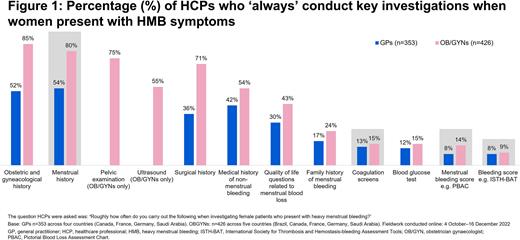Abstract

Background Heavy menstrual bleeding (HMB) affects millions of women around the world; one in five of which may have an undiagnosed underlying bleeding disorder. Despite this, healthcare providers (HCPs) have limited awareness of both the HMB clinical correlates and the association between HMB and bleeding disorders. Moreover, social stigma around menstruation further increases the challenges faced with timely diagnosis and management of HMB. Increasing HCP awareness will mark a turning point in HMB and bleeding disorder diagnosis and management.
Aims To investigate diagnosis and HCP awareness of HMB and bleeding disorders in women and girls.
Methods A two-phase research study was conducted by Brunswick (funded by Novo Nordisk) across Brazil, Canada, China, France, Germany, Saudi Arabia and Turkey (March-December 2021). For the purposes of this study, HMB was defined as: >8-day periods; and/or women describing their periods as 'very heavy' with a sensation of gushing and/or large clots; and/or women experiencing at least two of the following: soak through one or more sanitary product every 2 hours, simultaneous use of two types of sanitary protection, or stained bedsheets/clothes. Phase 1 included 11, 60-minute interviews with experts discussing HMB diagnostic barriers, these findings helped shape the questionnaires for the quantitative research in phase 2. In phase 2, online surveys were conducted with 6,099 women (aged 16-60 years) in the general population and 353 HCPs (general practitioners [GPs] and obstetrician/gynaecologists [OB/GYNs]). The sample size was ~1,000 in all countries, except Saudi Arabia and Turkey (sample size ~500). The samples were nationally representative, and age and regional quotas were applied to prevent a skew towards women with higher levels of education. Phase 2 included three, 1.5-2-hour workshops with 20 clinicians and patient advocates covering the topics of limited HMB knowledge, inconsistent criteria defining HMB, and better equipping HCPs for diagnosis.
Results Seventy-six percent of menstruating women believed they could recognise HMB symptoms 'well'. Yet 23% of these women would not have ≥8-day periods medically investigated. Twenty-two percent of GPs lack confidence when diagnosing HMB. Only 34% of GPs and 56% of OB/GYNs 'strongly associate' HMB since menarche with underlying bleeding disorders. Furthermore, a large proportion of HCPs do not perform key investigations for HMB symptoms. Thirteen percent of GPs and 15% of OB/GYNs perform coagulation screenings, and only 8% of GPs determine bleeding phenotype using screening tools to evaluate menstrual blood loss and obtain bleeding scores (Figure 1; grey boxes). Additionally, it is important to note that the data were somewhat impacted by the HCP's gender. Eighty-five percent of female OB/GYNs always assess menstrual history compared with 75% of male OB/GYNs. Eighty percent of female GPs always or nearly always assess menstrual history, compared to 67% of male GPs. This gender-based difference was not as significant when HCPs were questioned on their confidence with assessing women who presented with potential HMB symptoms. Only 26%/48% of male GPs and 30%/49% of female GPs were 'very confident'/'quite confident' that they would decide on the right course of action.
Conclusions Experts have emphasised the need for a standardised set of clinical criteria for HMB that is validated and well communicated to promote efficient diagnosis and management of women and girls with bleeding disorders. There is limited awareness among women and HCPs of important indicators of HMB, most HCPs do not recognise key indicators for bleeding disorders and do not perform key assessments for women with HMB.
Disclosures
Tarawah:Novartis: Honoraria, Other: Meeting/travel support; Sobi: Honoraria, Other: Meeting/travel support; Novo Nordisk: Honoraria, Other: Meeting/travel support; Takeda: Honoraria; Roche: Honoraria. Shridhar:Novo Nordisk Service Centre India Private Ltd: Current Employment. Kulkarni:Sanofi: Consultancy; Roche: Consultancy.
Author notes
 This icon denotes a clinically relevant abstract
This icon denotes a clinically relevant abstract
Asterisk with author names denotes non-ASH members.


This feature is available to Subscribers Only
Sign In or Create an Account Close Modal